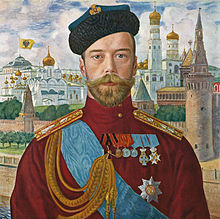Karakul hat

The Karakulmütze (QaraQul), according to the different names for the same coat also Astra Chan - (Astracan) or Persianer cap called ( Persian : قراقلی) is a headgear from the skin of the baby animal of the Karakulschafs . The article deals with men's hats made from karakul skin.
The typical model of the modern karakul hat for men is the so-called boat . It is worn with the edge facing you. In this form you can find them among other prominent followers of the Islamic faith in Central and partly in South Asia .
Spread and history
Gudea , Prince of Lagasch (reigned from 2040 to 2020 before the Common Era) was already wearing a cap that can be seen as curly fur. His son Ur-Ningirsu (2121 to 2118 BC) was also depicted with such a fur hat in an alabaster bust. The regular spirals clearly reflect the twisted locks of hair. In the Vorderasiatisches Museum in Berlin there is a statuette of the same Ur-Ningirsu on which the hair (on the cap?) Is depicted as a parallel wave pattern; towards the face, each of these serpentines ends in a spiral.
The headgear known as shuttles in German-speaking countries has its origins in Scotland and was known there in 1794 after its military introduction under the name Glengarry bonnet or Glengarry . Via the British Army, which introduced the modified form of the Glengarry known today in 1868, the boat found worldwide distribution in civil and military hat fashion and produced many local forms internationally.
In Bessarabia the typical headgear of the Bessarabian German men was a mostly black lambskin hat. The pelts came from the young of a Persian-like sheep that had been crossed with Karakul sheep. These lambskins are the finest of the Persian-like fur types, mostly they are already naturally black. Because of this similarity and according to the German RAL regulations, these half-blood Persian skins are traded as Bessarabians or Romanian half-Persians (not as Karakul or Persian).
The little boat that is often worn in Afghanistan is called the Kullah . If it is made of fur, it is usually made of karakul skin.
In 2013 it was reported from Moscow that the officially registered Cossacks who were regrouped as law enforcement officers have the right to wear a uniform: dark uniform jacket, trousers with wide red lampasses and a gray karakul cap.
The Russian writer Arzybaschew with a karakul hat and trimmings (1905)
Bessarabian German men with hats from "Romanian half-Persians" (around 1935)
Vladimir Putin with a Karakul peaked cap (2000)
Surpersian military cap , Azerbaijan (2017)
Karakul military cap, Kazakhstan (2019)
See also
Web links
Individual evidence
- ↑ Wolf-Eberhard Mourning: Karakulschafzucht . Association of allotment gardeners, settlers and small animal breeders, Berlin Central Association, specialization: noble fur breeders (ed.), 1967, pp. 6–9.
- ↑ Laurent Mirouze: Infantrymen of the First World War , Verlag Karl-Heinz Dissberger, Düsseldorf, ISBN 3-924753-28-8 , p. 10
- ^ Christian Franke / Johanna Kroll: Jury Fränkel's Rauchwaren-Handbuch 1988/89 , 10th revised and supplemented new edition, Rifra-Verlag Murrhardt, p. 297
- ↑ Dr. J. Niethammer: Fur animal skins in the bazaar in Kabul . In: Das Pelzgewerbe Vol. XVII / New Series, 1967 No. 1, Hermelin-Verlag Dr. Paul Schöps, Berlin et al., P. 7
- ↑ Doris Heimann: Russia's Cossacks in the Patriotic Trend. In “Rheinische Post”, Düsseldorf January 10, 2013, p. B9
- ↑ Putin is withheld from the army generals astrachan hats. They remain with the Russian Guard, FSB and Emergency Ministry , BBC, April 29, 2020 (Russian)








